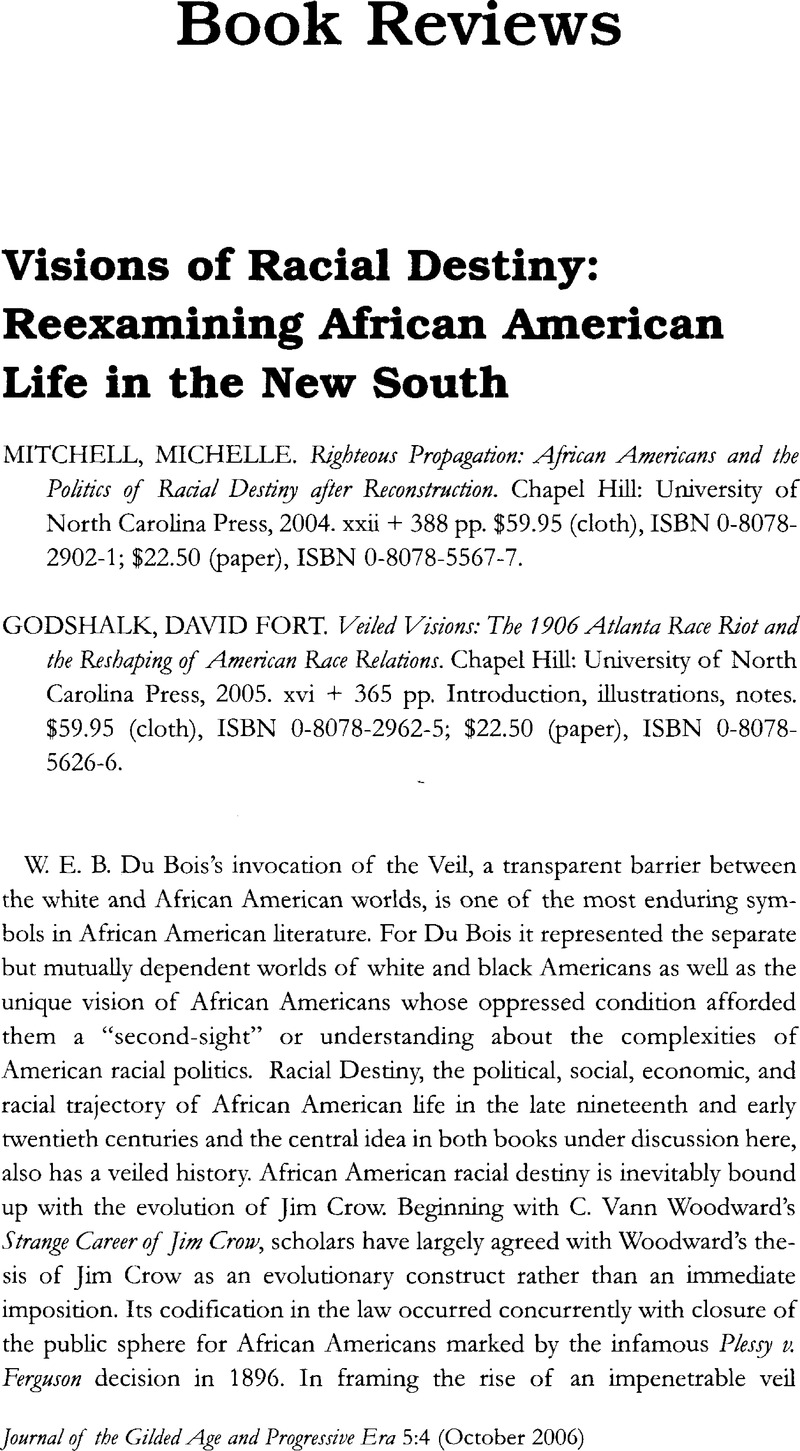No CrossRef data available.
Article contents
Visions of Racial Destiny: Reexamining African American Life in the New South - Michelle Mitchell. Righteous Propagation: African Americans and the Politics of Racial Destiny after Reconstruction. Chapel Hill: University of North Carolina Press, 2004. xxii + 388 pp. $59.95 (cloth), ISBN 0-8078-2902-1; $22.50 (paper), ISBN 0-8078-5567-7. - David Fort Godshalk. Veiled Visions: The 1906 Atlanta Race Riot and the Reshaping of American Race Relations. Chapel Hill: University of North Carolina Press, 2005. xvi + 365 pp. Introduction, illustrations, notes. $59.95 (cloth), ISBN 0-8078-2962-5; $22.50 (paper), ISBN 0-8078-5626-6.
Review products
Published online by Cambridge University Press: 08 November 2010
Abstract

- Type
- Book Reviews
- Information
- The Journal of the Gilded Age and Progressive Era , Volume 5 , Issue 4 , October 2006 , pp. 403 - 410
- Copyright
- Copyright © Society for Historians of the Gilded Age and Progressive Era 2006
References
1 Penn, Rosalyn Terborg, African American Women and the Struggle for the Vote, 1850-1920 (Bloomington, IN, 1998)Google Scholar; Hine, Darlene Clark, Black Women in White: Racial Conflict and Cooperation in the Nursing Profession, 1890-1950 (Bloomington, IN, 1989)Google Scholar; Gilmore, Glenda, Gender and Jim Crow: Women and the Politics of White Supremacy in North Carolina, 1896-1920 (Chapel Hill, 1996)Google Scholar; Rouse, Jacqueline, Lugenia Burns Hope, Black Southern Reformer (Athens, GA, 1989)Google Scholar; Neverdon-Morton, Cynthia, Afro-American Women and the Advancement of the Race, 1895-1925 (Knoxville, TE, 1989)Google Scholar; and Shaw, Stephanie, What a Woman Ought To Be and To Do: Black Professional Women in the Jim Crow South (Chicago, 1996)CrossRefGoogle Scholar.
2 Examples of this literature include Kelley, KevinGaines, Uplifting the Race: Black leadership, Politics, and Culture in the Twentieth Century (Chapel Hill, 1996)Google Scholar; Dailey, Jane, Before Jim Crow: The Politics of Race in Post-Emancipation Virginia (Chapel Hill, 2000)CrossRefGoogle Scholar; Hunter, Tera, To Joy My Freedom: Southern Black Women's Lives and Labors after the Civil War (Cambridge, MA, 1997)Google Scholar; Dailey, Jane, Gilmore, Glenda, and Simon, Bryant, eds., Jumpin Jim Crow: Southern Politics from Civil War to Civil Rights (Princeton, 2000)Google Scholar; Moore, Jacqueline, Leading the Race: The Transformation of the Black Elite in the Nation's Capital, 1880-1920 (Charlottesville, VA, 1999)Google Scholar; Schechter, Patricia, Ida B. Wells-Barnett and American Reform, 1880-1930 (Chapel Hill, 2001)Google Scholar; Dorsey, Allison, To Build Our Lives Together: Community Formation in Black Atlanta, 1875-1906 (Athens, GA, 2004)Google Scholar; Jenkins, Earnestine and Hine, Darlene Clark, A Question of Manhood: A Reader in U.S. Black Men's History and Masculinity, Vol 2, The Nineteenth Century from Emancipation to Jim Crow (Bloomington, IN, 2001)Google Scholar; Summers, Martin, Manliness and Its Discontents: The Black Middle Class and the Transformation of Masculinity, 1900-1930 (Chapel Hill, 2004)Google Scholar.
3 The literature on race riots is quite extensive. The Wilmington, North Carolina Massacre in 1898 and the Tulsa, Oklahoma Riot of 1921 have received considerable attention in the recent literature. See Cecelski, David and Tyson, Timothy B., eds., Democracy Betrayed: The Wilmington Riot of 1898 and Its legacy (Chapel Hill, 1998)CrossRefGoogle Scholar. On the Tulsa riot, see Ellsworth, Scott, Death in the Heartland: The Tulsa Riot of 1921 (Baton Rouge, 1982)Google Scholar, and Madigan, Tim, The Burning: Massacre, Destruction, and the Tulsa Race Riot of 1921 (New York, 2001)Google Scholar.


